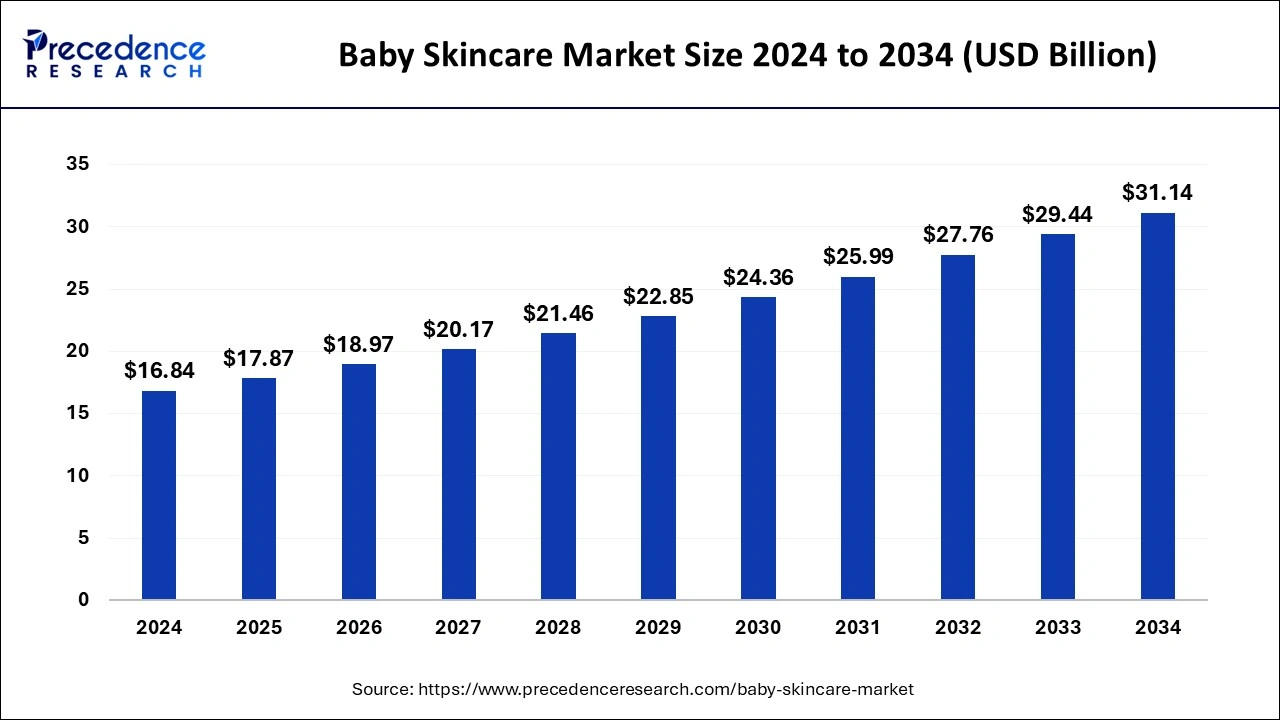September 2024
The global baby skincare market size is calculated at USD 17.87 billion in 2025 and is forecasted to reach around USD 31.14 billion by 2034, accelerating at a CAGR of 6.34% from 2025 to 2034. The Asia Pacific baby skincare market size surpassed USD 6.74 billion in 2024 and is expanding at a CAGR of 6.33% during the forecast period. The market sizing and forecasts are revenue-based (USD Million/Billion), with 2024 as the base year.
The global baby skincare market size was accounted for USD 16.84 billion in 2024 and is anticipated to reach around USD 31.14 billion by 2034, growing at a CAGR of 6.34% from 2025 to 2034. The global baby skincare market growth is attributed to the increasing disposable income in emerging countries, the rising demand for organic and natural baby skincare products and increasing awareness of baby skin health among parents.

Artificial intelligence is revolutionizing various industries, and the baby skincare industry is one of them. AI-generated technologies provide innovative solutions that ensure convenient, healthier, and safer parenting. AI-personalized skincare recommendations and used to analyze a baby’s skin to address their needs. AI helps in the early detection of skin-related problems such as psoriasis and eczema. In addition, the development of new skincare products with the help of artificial intelligence is the major trend in infant skincare which is expected to transform the growth of the baby skincare market. Furthermore, AI can be utilized to establish new skincare products that are gentle on a baby’s skin and are more effective.
The U.S. baby skincare market size was exhibited at USD 6.74 billion in 2024 and is projected to be worth around USD 12.45 billion by 2034, growing at a CAGR of 6.33% from 2025 to 2034.

Asia-Pacific dominated the baby skincare market in 2024 with a revenue share of 30%. The baby skincare market in the region is being driven by a rise in brand penetration and a broad distribution network. The growth of the market is being aided by the e-commerce sector.

North America, on the other hand, is expected to develop at the fastest rate during the forecast period. The increased research and development expenditures by businesses would boost the baby skincare market growth in North America region.
| Report Coverage | Details |
| Market Size in 2025 | USD 17.87 Billion |
| Market Size by 2034 | USD 31.14 Billion |
| Market Growth Rate from 2025 to 2034 | CAGR of 6.34% |
| Largest Market | Asia Pacific |
| Base Year | 2024 |
| Forecast Period | 2024 to 2034 |
| Segments Covered | Product, Distribution Channel, Age Group, and Region |
| Regions Covered | North America, Europe, Asia-Pacific, Latin America and Middle East & Africa |
The increasing demand for organic and natural baby skincare products
As millennial parents are more educated and informed, they prefer natural and organic baby skincare products to avoid the adverse effects of chemical components on their child’s skin. As more women enter the workforce, disposable income rises, allowing for the purchase of high-quality healthcare supplies. As a result, the baby skincare market expansion is accelerated.
By age group, the 0-6 months segment led the global market. At this age, babies need constant care, including skin care to tend to their sensitive and fragile skin. Rising disposable incomes have led to more families being able to afford premium products for their babies. The increasing focus on wellness, as well as safe, clean, and baby-safe skincare, is the reason this segment leads.
By age group, the 7-12 months segment is predicted to witness significant growth in the market over the forecast period. New parents today are more informed about child and baby care with increased access to information about child development. This growing emphasis on active parenting is leading to parents being more responsive to a baby's needs and potential concerns. This is leading to higher demand for baby skincare in this segment.
In 2024, the creams segment dominated the baby skincare market. The primary purpose of baby lotions and creams is to hydrate and protect the skin from drying out. The diaper rash creams, on the other hand, are used to provide a barrier between the skin of the infant and the wet diapers, preventing irritation.
The oil segment, on the other hand, is predicted to develop at the quickest rate in the future years. The traditional infant massage oils are used to calm and soothe a baby’s sensitive skin. The olive oil, coconut oil, and aloe oil are used as baby skin care products on a large scale.
The supermarkets & hypermarkets segment dominated the baby skincare market in 2024. The supermarkets and hypermarkets provide wide range of baby skin care products. These products are available on discounts in these stores, which is boosting the expansion of the supermarkets and hypermarkets segment over the projection period. The Amazon and Walmart are implementing various strategies for the increased sales of baby skin care products.
The online segment is fastest growing segment of the baby skincare market in 2024. The factors such as high rate of internet penetration, growing usage of smartphones and tablets, and easy availability of wide variety of products are driving the growth of the online segment during the forecast period.
Segments Covered in the Report
By Products
By Distribution Channel
By Age Group
By Geography
For inquiries regarding discounts, bulk purchases, or customization requests, please contact us at sales@precedenceresearch.com
No cookie-cutter, only authentic analysis – take the 1st step to become a Precedence Research client
September 2024
October 2024
June 2024
November 2024